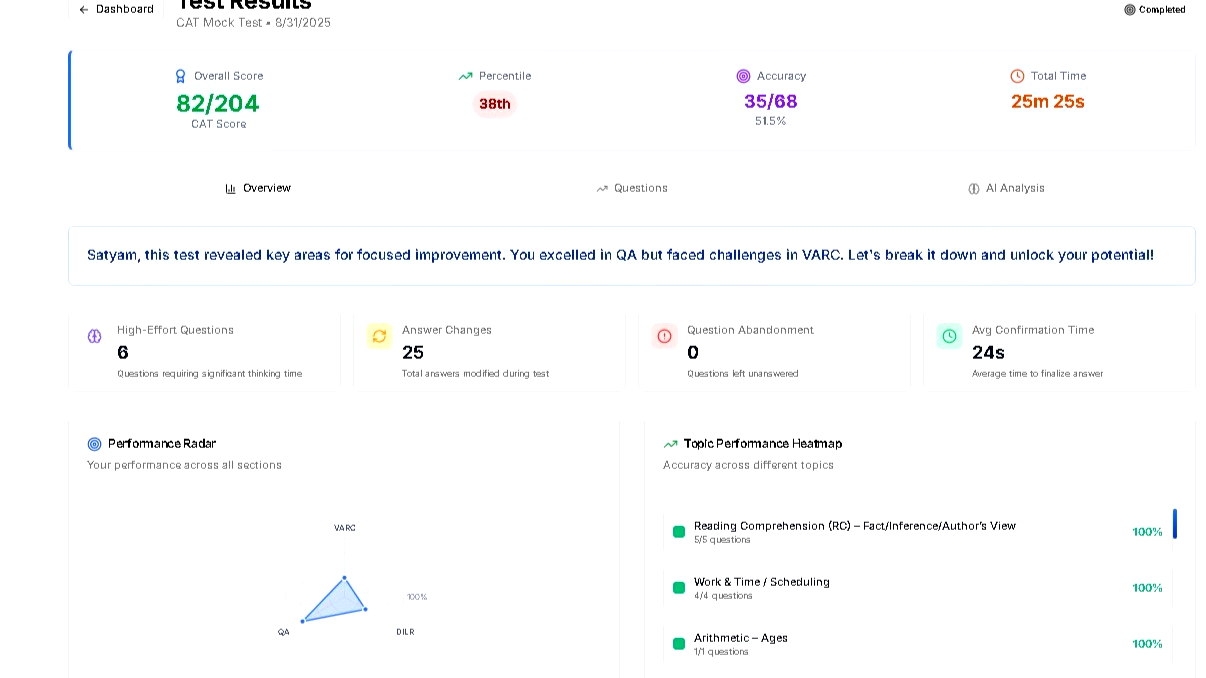Strategic section-wise preparation is the cornerstone of CAT success, with each component requiring distinct approaches, time allocation strategies, and practice methodologies. Understanding the unique challenges and opportunities within Verbal Ability & Reading Comprehension (VARC), Data Interpretation & Logical Reasoning (DILR), and Quantitative Aptitude (QA) can dramatically improve your overall percentile.
Understanding CAT's Three-Section Architecture
Section Distribution and Timing
Each CAT section operates under strict 40-minute time constraints with no inter-section movement allowed. This structure demands:
Independent mastery of each section's question types
Optimized time allocation within each 40-minute window
Section-specific strategies tailored to unique difficulty patterns
Balanced preparation across all three components
VARC: Verbal Ability & Reading Comprehension Mastery
Reading Comprehension Dominance Strategy
Reading Comprehension passages constitute 70-80% of VARC scoring opportunities, making them the section's primary focus area.
Passage Selection Hierarchy
Business and Economics - Most predictable themes
Social Sciences - Moderate complexity with clear arguments
Literature and Arts - Requires broader cultural knowledge
Science and Technology - Often data-heavy and technical
RC Time Management Framework
Passage Reading: 3-4 minutes per passage
Question Solving: 1.5-2 minutes per question
Review and Selection: 30 seconds per question for attempt decisions
Verbal Ability Question Types Strategy
Para Jumbles Mastery
Para jumbles require systematic approach:
Identify opening and closing sentences first
Look for logical connectors and transitional phrases
Practice 2-3 para jumbles daily for pattern recognition
Focus on context clues rather than grammar rules
Critical Reasoning Excellence
Assumption identification through elimination method
Strengthen/weaken argument analysis techniques
Inference drawing based on passage limitations
Summary and conclusion logical flow assessment
VARC Preparation Timeline
Foundation Phase (Months 4-6 before CAT)
Daily reading habit: 1-2 hours of quality content
Vocabulary building: 20-25 new words daily with contextual usage
Basic grammar revision: Focus on sentence correction patterns
Intensive Phase (Months 2-3 before CAT)
RC practice: 2-3 passages daily with timed solving
VA question drilling: 10-15 questions daily across all types
Weekly sectional mocks: Analyze accuracy vs. speed balance
DILR: Data Interpretation & Logical Reasoning Excellence
Data Interpretation Mastery Approach
Chart and Graph Analysis Skills
DI questions test analytical thinking over mathematical complexity:
Bar charts: Focus on comparative analysis and trend identification
Line graphs: Emphasis on rate of change and inflection points
Pie charts: Percentage calculations and proportional reasoning
Tables: Multi-dimensional data cross-referencing skills
Calculation Optimization Techniques
Approximation mastery: Round numbers for faster calculations
Percentage shortcuts: Use fraction equivalents for quick computations
Ratio and proportion: Identify direct relationships to avoid complex calculations
Average and median: Use properties for swift problem-solving
Logical Reasoning Strategic Framework
Puzzle-Solving Hierarchy
Seating Arrangements: Linear and circular configurations
Blood Relations: Family tree construction and relationship mapping
Syllogisms: Venn diagram applications and logical conclusions
Coding-Decoding: Pattern recognition and systematic approaches
Time-Intensive vs. Quick-Solve Classification
Quick-Solve Categories (2-3 minutes per question):
Simple data sufficiency problems
Basic coding-decoding patterns
Direct logical reasoning questions
Time-Intensive Categories (4-5 minutes per set):
Complex seating arrangement puzzles
Multi-variable logical games
Intricate data interpretation sets
DILR Section Strategy During Exam
Question Selection Protocol
First 5 minutes: Scan all sets and identify 2-3 manageable ones
Next 30 minutes: Solve selected sets completely
Final 5 minutes: Attempt individual solvable questions from remaining sets
QA: Quantitative Aptitude Systematic Mastery
Topic-wise Weightage and Preparation Priority
High-Weightage Areas (35-40% of questions)
Arithmetic: Number systems, percentages, profit & loss, time & work
Algebra: Linear and quadratic equations, functions, sequences
Geometry: Coordinate geometry, mensuration, triangles
Medium-Weightage Areas (25-30% of questions)
Modern Mathematics: Permutation & combination, probability
Trigonometry: Basic ratios and identities
Logarithms: Properties and applications
QA Problem-Solving Methodology
Speed vs. Accuracy Balance
Implement the 30-60-90 Rule:
30% Easy Questions: Solve within 1-1.5 minutes each
60% Medium Questions: Allocate 2-2.5 minutes per problem
10% Difficult Questions: Either solve in 3-4 minutes or skip strategically
Concept Application Framework
Pattern Recognition: Identify question type within 15 seconds
Method Selection: Choose optimal solving approach immediately
Execution: Apply shortcuts and standard formulas efficiently
Answer Verification: Quick reasonableness check before moving forward
QA Practice Methodology
Conceptual Mastery Phase
Topic-wise drilling: 15-20 problems per concept daily
Formula compilation: Create personalized formula sheets
Shortcut techniques: Master calculation optimization methods
Error pattern analysis: Document recurring mistake types
Speed Building Phase
Timed practice sessions: Solve problem sets under strict time limits
Mental calculation improvement: Reduce dependency on written work
Question type clustering: Practice similar problems in groups for efficiency
Integrated Section Strategy: Mock Test Utilization
Sectional Mock Test Schedule
Weekly Practice Distribution
2 Full-length CAT mocks: Complete exam simulation
2 VARC sectional mocks: Reading speed and accuracy focus
2 DILR sectional mocks: Pattern recognition and time management
2 QA sectional mocks: Speed building and concept application
Cross-Section Performance Analysis
Percentile Balance Strategy
Avoid over-dependence on single section strength:
Target 85+ percentile in strongest section
Maintain 75+ percentile in moderate section
Achieve 65+ percentile minimum in weakest section
Time Allocation Optimization
Track sectional time usage patterns:
VARC: Prioritize high-accuracy question selection
DILR: Focus on complete set solutions over partial attempts
QA: Balance between speed and calculation accuracy
Advanced Preparation Techniques
Error Analysis and Course Correction
Section-specific Mistake Patterns
VARC Common Errors:
Over-analysis of reading comprehension passages
Rushing through para jumbles without systematic approach
Ignoring context clues in critical reasoning
DILR Common Errors:
Starting complex puzzles without complete information scanning
Making calculation errors under time pressure
Leaving partially solved sets incomplete
QA Common Errors:
Calculation mistakes in easy questions
Over-complicating problems with lengthy methods
Poor time allocation between question difficulties
Peak Performance Maintenance
Consistency Building Strategy
Daily practice routine: Maintain 2-3 hours of focused section work
Weekly performance tracking: Monitor percentile trends across sections
Monthly strategy revision: Adjust approaches based on mock test patterns
Stress management: Practice relaxation techniques for exam day composure
FAQ Section
Which CAT section should I prioritize if I'm short on preparation time?
Focus on VARC first as it offers the most consistent scoring opportunities through reading comprehension, followed by QA fundamentals for reliable accuracy-based scores.
How do I balance speed and accuracy across different sections?
VARC emphasizes accuracy over speed, DILR requires complete set solutions, and QA demands balanced approach with strategic question selection based on difficulty assessment.
What's the ideal sectional mock test frequency?
Take 2 sectional mocks per section weekly along with 2 full-length mocks, ensuring adequate analysis time between attempts for improvement implementation.
How should I adjust my section strategy closer to the exam?
Final month focus: Perfect your question selection process, optimize time allocation based on mock test patterns, and maintain consistency rather than attempting major strategy changes.
Which section typically determines overall CAT percentile?
While QA often determines high percentiles due to scoring potential, consistent performance across all three sections is crucial for top-tier MBA program qualification, as most institutes have sectional cut-offs.
Section-wise CAT preparation transforms raw preparation effort into strategic performance optimization, ensuring that your strengths are maximized while weaknesses are systematically addressed through targeted practice and analysis.




